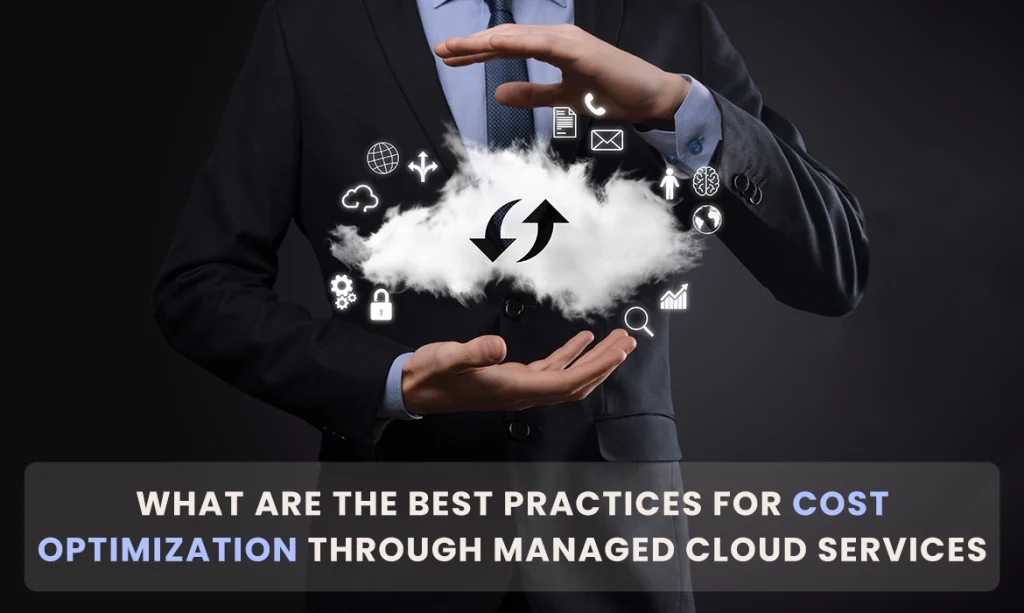Managed cloud services play a major role in driving productivity and fostering growth in today’s rapidly evolving corporate landscape. By partnering with specialized providers, companies can delegate complex cloud management tasks, allowing them to focus on their core competencies.
Managed cloud services offer a flexible, robust, and cost-effective infrastructure tailored to each enterprise’s unique needs. This external assistance not only enhances operational productivity but also enables companies to leverage IT assets efficiently, reduce pressure on in-house IT departments, and concentrate on strategic initiatives. These services align with Business Continuity Disaster Recovery (BCDR) strategies, helping achieve lower Recovery Point Objectives (RPO) and Recovery Time Objectives (RTO), ultimately leading to cost savings.
Scalability is a key advantage, allowing enterprises to adjust resources based on demand, swiftly adapting to market fluctuations. Cost-effectiveness is inherent in cheap cloud hosting services, eliminating the need for substantial upfront investments and transforming expenditures into operational costs. Security and regulatory compliance are paramount, with managed cloud service providers deploying robust security protocols, firewalls, encryption, redundant systems, and disaster recovery strategies to safeguard confidential data and ensure business continuity.
Table of Contents
Understanding Managed Cloud Services

Managed cloud services provide businesses with a comprehensive solution for overseeing their cloud-based services and IT infrastructure. Collaborating with a managed cloud services provider enables businesses to delegate the intricacies of cloud management, allowing them to focus on their core competencies. Let’s delve into the fundamental aspects of managed cloud services:
Infrastructure Management:
- Managed cloud hosting services oversee the establishment, configuration, and maintenance of infrastructure, including servers, storage, networking, and virtualization technologies.
- Leveraging the provider’s infrastructure expertise ensures optimal functionality, scalability, and reliability of the cloud environment.
Security Measures and Data Protection:
- Comprehensive security measures are deployed by managed cloud service providers to secure sensitive data and mitigate risks.
- State-of-the-art security protocols, firewalls, intrusion detection systems, data encryption, access control, and regular security audits are integral components of their security strategy.
Round-the-Clock Monitoring and Support:
- Continuous monitoring and support for the cloud infrastructure are offered by managed cloud services providers.
- Proactive monitoring of system performance, rapid issue identification and resolution, and ensuring optimal uptime contribute to dependable access to cloud services.
Scalability and Resource Management:
- Cheap cloud hosting services provide businesses with the flexibility to scale IT resources according to demand.
- Rapid resource allocation, whether for storage capacity, computing power, or network expansion, enables businesses to adapt to changing needs without significant infrastructure investments.
Backup and Disaster Recovery:
- Robust backup and disaster recovery solutions are implemented by managed cloud services providers.
- Regular data backups ensure integrity, and efficient recovery options minimize the impact of data loss or system failures, allowing swift business resumption during unexpected incidents.
Cost Efficiency:
- Managed cloud hosting services optimize cloud costs by offering a subscription-based model.
- This eliminates upfront investments in hardware and infrastructure, aligning costs with usage and avoiding expenses associated with maintaining an in-house IT team for cloud management.
Expertise and Support:
- Providers of managed cloud services bring deep expertise and specialized knowledge in cloud technologies.
- Proficient professionals stay updated on industry trends, best practices, and emerging technologies, providing businesses with expert advice and support throughout their cloud journey.
By partnering with a provider of affordable cloud hosting services, businesses can delegate cloud management complexities and leverage the provider’s expertise, infrastructure, and support. This enables a focus on core competencies, boosts operational efficiency, enhances security, and stimulates innovation.
Cloud Cost Optimization: Efficiency, Scalability, and Cost Savings

In the dynamic landscape of cloud computing, achieving optimal cost management is paramount for businesses seeking efficiency, scalability, and significant savings. Cloud Cost Optimization, a strategic imperative, revolves around maximizing the value of cloud services while minimizing expenses. Here, we delve into the key pillars of Cloud Cost Optimization: Efficiency, Scalability, and Cost Savings.
Efficiency: Streamlining Operations for Maximum Output
Efficiency in cloud cost management involves fine-tuning operations to eliminate waste and enhance resource utilization. By leveraging automation, monitoring tools, and expert management, businesses can optimize workflows, ensuring that every cloud resource contributes meaningfully to operational goals. Proactive monitoring, streamlined processes, and strategic resource allocation are pivotal in achieving efficiency gains.
Scalability: Adapting to Changing Needs with Ease
Scalability is a cornerstone of Cloud Cost Optimization, offering businesses the agility to adjust resources according to demand fluctuations. Cloud services enable seamless scaling up or down, ensuring that organizations can meet evolving requirements without unnecessary expenses during periods of reduced demand. This flexibility is fundamental for adapting to market dynamics, accommodating growth, and optimizing resource allocation.
Cost Savings: A Pragmatic Approach to Expenditure
Cost Savings are at the heart of Cloud Cost Optimization, representing a shift from traditional capital expenditures to more flexible operational expenses. Managed cloud services, pay-as-you-go models, and scalable pricing structures empower businesses to pay only for what they use. This approach reduces upfront investments, eliminates the need for extensive infrastructure maintenance, and prevents unnecessary spending on underutilized resources, ultimately contributing to substantial savings.
The Symbiosis of Efficiency, Scalability, and Cost Savings
Efficiency, Scalability, and Cost Savings are interlinked components of an effective Cloud Cost Optimization strategy. Streamlining operations not only enhances efficiency but also contributes to cost savings by eliminating inefficiencies. Scalability complements efficiency by ensuring that resources align with dynamic business needs, preventing both underutilization and over-provisioning. Together, these elements create a harmonious and cost-effective cloud environment.
In conclusion, Cloud Cost Optimization is a multifaceted approach that integrates efficiency, scalability, and cost savings. By adopting strategies that align with these pillars, businesses can navigate the complexities of cloud expenses, optimize their operations, and unlock the full potential of cloud computing in a financially prudent manner.
Security, Compliance, and Business Continuity

In the ever-evolving landscape of digital business, three essential pillars—Security, Compliance, and Business Continuity—stand as guardians of resilient and reliable operations.
Security: Safeguarding Digital Fortresses
Protecting Confidentiality and Integrity:
Security is the bedrock, ensuring the confidentiality and integrity of sensitive data. Robust security measures, including encryption, firewalls, and intrusion detection systems, shield businesses from evolving cyber threats. By fostering a culture of cybersecurity awareness, organizations fortify their digital fortresses against unauthorized access and data breaches.
Continuous Monitoring and Incident Response:
Continuous monitoring is imperative to swiftly identify and respond to potential security breaches. A proactive approach, coupled with well-defined incident response plans, empowers organizations to mitigate risks promptly, minimizing the impact of security incidents on business operations.
Compliance: Navigating Regulatory Landscapes
Meeting Regulatory Requirements:
Compliance ensures that businesses adhere to industry-specific regulations and standards. Navigating complex regulatory landscapes requires a comprehensive understanding of compliance requirements. Implementing robust policies and procedures not only prevents legal repercussions but also fosters trust among stakeholders by showcasing a commitment to ethical and responsible business practices.
Data Governance and Privacy Protection:
Effective compliance encompasses meticulous data governance and protection of individual privacy. By aligning operations with regulatory frameworks, organizations not only avoid penalties but also build a foundation of trust with customers who entrust them with their personal information.
Business Continuity: Ensuring Uninterrupted Operations
Mitigating Disruptions:
Business Continuity is the assurance that operations persist even in the face of disruptions. Robust disaster recovery plans, redundant systems, and backup strategies safeguard against unexpected events, such as natural disasters or system failures. The goal is to minimize downtime and data loss, allowing for the swift recovery of critical business functions.
Resilience in the Face of Challenges:
Business Continuity planning goes beyond technical aspects to encompass resilient organizational structures. By fostering a culture of adaptability and preparedness, businesses can navigate challenges with agility, ensuring that they emerge stronger from unforeseen disruptions.
In essence, Security, Compliance, and Business Continuity are interconnected elements forming the foundation of resilient business operations. By prioritizing these pillars, organizations not only protect themselves from potential threats but also lay the groundwork for sustained growth, customer trust, and long-term success in the dynamic digital landscape.
Wrapping Up
In the dynamic realm of cloud services, achieving cost optimization through managed solutions is vital for business success. Our exploration of best practices reveals that cloud efficiency demands a strategic fusion of methodologies, technologies, and collaboration. Selecting the right provider, embracing auto-scaling, and leveraging monitoring tools lay the foundation for resource optimization.
Balancing resource size, adopting serverless architectures, and fortifying security measures ensure every aspect contributes to efficiency. Real-world case studies offer practical insights, emphasizing the need for continuous improvement and adaptation. As businesses embark on this journey, the promise of enhanced productivity, scalability, and cost savings becomes a reality.
Also Read:- The Benefits Of Cloud Hosting Servers









